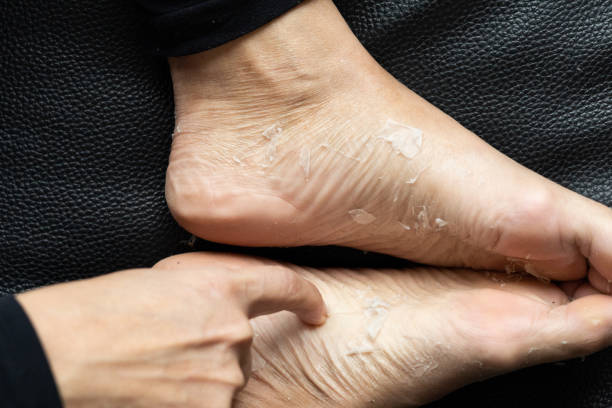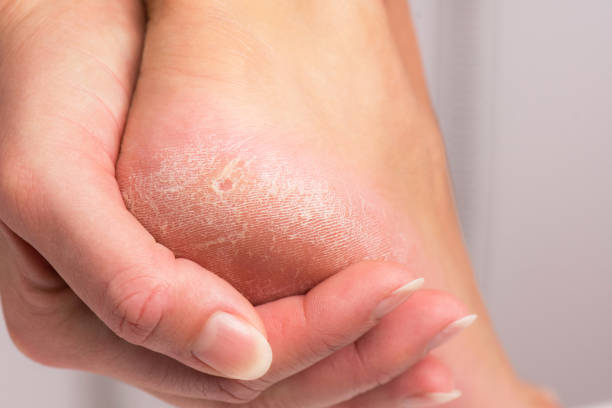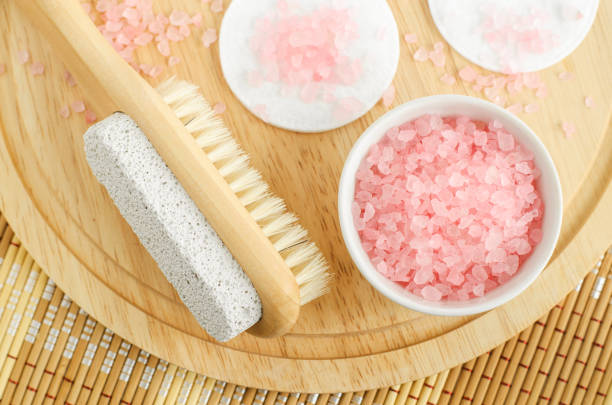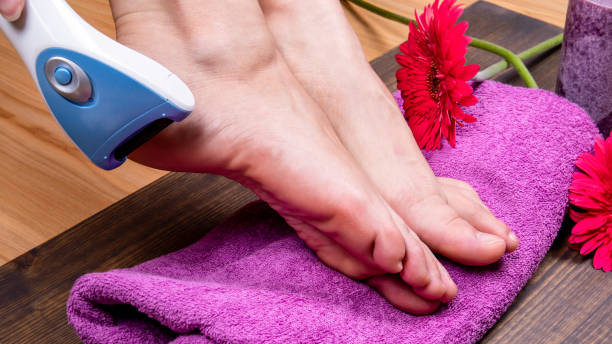How To Remove Dead Skin From Feet? How To Prevent?

It’s typical for feet to have dry, brittle, or cracked skin. The feet are subject to daily wear and tear and have fewer oil glands than other parts of the body. Some easy home remedies can be used to treat dry skin on the feet.
The sides, heels, and spaces in between the toes of the feet frequently develop dry skin. It may cause the affected area to feel tight, achy, and even painful. Although it might annoy you, this rarely causes harm.
Simple foot soaks, moisturizers, and routine exfoliation can help to remove calluses, dead skin, and other areas of dry skin on the feet.
We examine the causes and remedies for dry, chapped, or scaly skin on the feet in this article.
Table of Contents
What Causes Dead Skin on the Feet?
A Lack of Moisture.
Because the heel and sole have fewer oil glands than other parts of the body, dry, cracked, and flaky skin is more prevalent there.
Irritation.
Long periods of standing or wearing shoes that don’t fit properly can put constant pressure on certain parts of the feet or cause the skin to rub together. These parts of the feet may consequently become dry, calloused, or cracked.
Heat and Humidity.
A very warm and muggy environment is produced for the feet by closed shoes like boots and sneakers. Heat and humidity dehydrate the skin, causing areas of the feet to become dry, thick, or cracked.
Soaps.
Body washes and soaps with irritating or harsh ingredients can dry out the skin. These issues can also arise if the feet are not thoroughly washed with excess soap.
Aging.
Skin loses its capacity to hold onto water over time, thinning and losing some of its elasticity. As a result of the natural aging process, older people may be more likely to experience dry skin.
Medications.
Diuretics and other medications can contribute to dry skin on the feet.

Methods to Try
Pumice Stone
Pumice stones, which are made of natural lava, are a common way to get rid of calluses and dead skin from your feet. Before beginning, soak your feet in warm water for 15 to 20 minutes for the best results. It only takes a few simple steps to remove dead skin from your feet: dunk the pumice stone in warm water, then gently rub it over your foot in circular motions. When the top layer of dead skin is removed, stop immediately because redness or bleeding indicates that you have gone too far.), then apply lotion or foot cream to finish. On broken skin or an injured area, a pumice stone should never be used.
Foot Scrub
Foot scrubs remove dead skin from your feet physically and are easily found at drugstores and pharmacies. Simply rub a scrub onto your foot by hand, with a sponge, or with a scrub brush. After finishing, thoroughly rinse your feet with water and then apply lotion to your feet to keep the moisture in.
Paraffin Wax
After getting your feet manicured, you can usually add on this service at the salon or do it yourself at home. It melts at a temperature of about 125°F, which is warm enough to be effective but not hot enough to burn your skin. Paraffin wax is a type of soft wax. Your feet are covered in plastic after being repeatedly dipped in paraffin wax until a few layers have been applied. Your feet’s dead skin is removed along with the plastic when the wax hardens, leaving them soft and smooth.
Paraffin wax isn’t a good option for everyone, especially if you have an open wound, sore, or rash on your feet, have poor blood circulation, or have lost feeling in your feet. In order to prevent burning yourself during the procedure if you’re performing it at home, be sure to carefully control the wax’s temperature with a thermometer.
Epsom Salt Soak Or Scrub
Epsom salt, a crystallized form of the mineral compound magnesium sulfate, is a fantastic natural treatment for removing dead skin from the feet. After dissolving the Epsom salt in water, soak your feet to exfoliate the skin. For a warm water tub, add a full cup of Epsom salt, or use half a cup for a foot bath. Use a foot brush or pumice stone to help remove dead skin from your feet after 20 minutes. Additionally, you can make a foot scrub by mixing a handful of Epsom salt with a tablespoon of oil or bath oil, then using your hands or a bath sponge, to exfoliate the feet. Take off as much dead skin as you can before giving your feet a thorough rinse.

Vinegar Soak
A vinegar soak softens, removes, and repairs cracked feet by removing dead skin. Any type of vinegar will work, and chances are you already have white vinegar or apple cider vinegar in your kitchen. Use one part vinegar to two parts cool water, and soak feet for five to ten minutes. To remove the loose skin with more force, you can use a pumice stone. To lock in the moisture after the soak, apply lotion before slipping on some socks.
Heel File
A heel file or emery board, which works similarly to a pumice stone in exfoliating and smoothing skin and removing calluses, is used for similar purposes. After soaking the area in warm water to soften the dry skin, use the heel file to remove it. When finished, rinse your feet, apply lotion, and put on socks to trap moisture.
Wear the Right Shoes
Calluses are frequently caused by wearing shoes that are too tight or don’t fit well. Make sure your shoes, especially your running shoes, are the right size for you, leaving at least an inch between your toes to avoid blisters and calluses. Keep a few pairs in constant rotation because wearing the same pair of shoes all the time can also lead to foot issues.
Stop Friction
Preventing calluses in the first place is the simplest method of treatment. Before you put on your socks if you know where on your feet they tend to develop, such as along your toes, place a piece of moleskin there to stop your shoes from rubbing against those areas.

Use With Caution
Baking Soda Soak
For the removal of dead skin from the feet, baking soda is a popular at-home remedy.
However, some dermatologists caution that using baking soda can irritate the skin, cause redness, and cause the skin to become even drier. This is due to the possibility that it will upset the skin’s normal pH balance.
Avoid using baking soda on your feet if you have any skin allergies or sensitivities. Before attempting a new treatment, always consult with your physician or podiatrist.
If you do decide to use baking soda, only use a small amount (2–3 tablespoons) in a full footbath of warm water for 10–20 minutes.
Use a pumice stone or foot brush to remove dead skin after your soak in order to gently exfoliate the feet. Following, liberally apply moisturizer.
As soon as you notice any redness or irritation, stop soaking your feet in the solution.
Lemon Water Soak
Lemon’s acidity might assist in removing dead skin cells from your feet.
Lemon may, like baking soda, disrupt the pH balance of the skin, causing more dryness and dead skin to develop.
Avoid lemon if you:
• have any cuts or open sores on your foot
• have sensitive skin
• experience any redness and irritation
Before using lemon, or if you have any questions or concerns, consult a podiatrist or dermatologist.
If you decide to use this method:
• Warm water should be ready for a foot bath.
• Add the juice of one lemon. Lemon peel pieces can also be left in the water.
• Give your feet a 15-minute soak.
• To remove dead skin from your feet, use a foot brush.
• Your feet should be thoroughly cleaned and dried. If desired, use coconut oil or a moisturizer.
Razor Or Scraper
To remove a callous or dead skin from your foot with a razor or scraper, only allow a podiatrist or other qualified medical specialist to do so.
On your feet at home, avoid using scrapers or razors. Your foot might become damaged or you might develop another medical condition if you do this.
For instance, you run the risk of developing a bacterial infection if you cut yourself accidentally.
Consult your doctor for alternative medications or at-home remedies if you’re worried about removing dry or dead skin.
How to Prevent Dead Skin on the Feet
The best way to prevent dead skin from forming on your feet is to moisturize regularly.
To help stop your skin from drying out, ask your podiatrist for recommendations on therapeutic oils, ointments, or creams.
Avoid lotions with alcohol in them as they might make your feet even drier. Typically safe options include baby oil or petroleum jelly.
Several times a week, soak your feet, then gently scrub the dead skin off with a pumice stone or foot brush.
To keep skin from drying out, stay away from hot showers and baths and rinse in warm water.
Summary: Moisturize Regularly
Dry, itchy feet and patches of irritated or scaly skin can be caused by wearing the wrong shoes or spending too much time standing. Leaving the feet susceptible to infection, dry skin can thicken and crack open if left untreated.
To remove dead skin on the feet, people can use pumice stones, exfoliators, and foot soaks at home. The feet can be kept hydrated and healthy by regularly applying moisturizer and exfoliating dead skin.
The skin on the feet can become extremely dry due to certain illnesses like eczema, hypothyroidism, and diabetes.
People who have extremely dry, cracked skin on their feet may want to talk to a podiatrist—a type of foot specialist—or another healthcare provider to learn about possible treatments.
Tags: Dead Skin